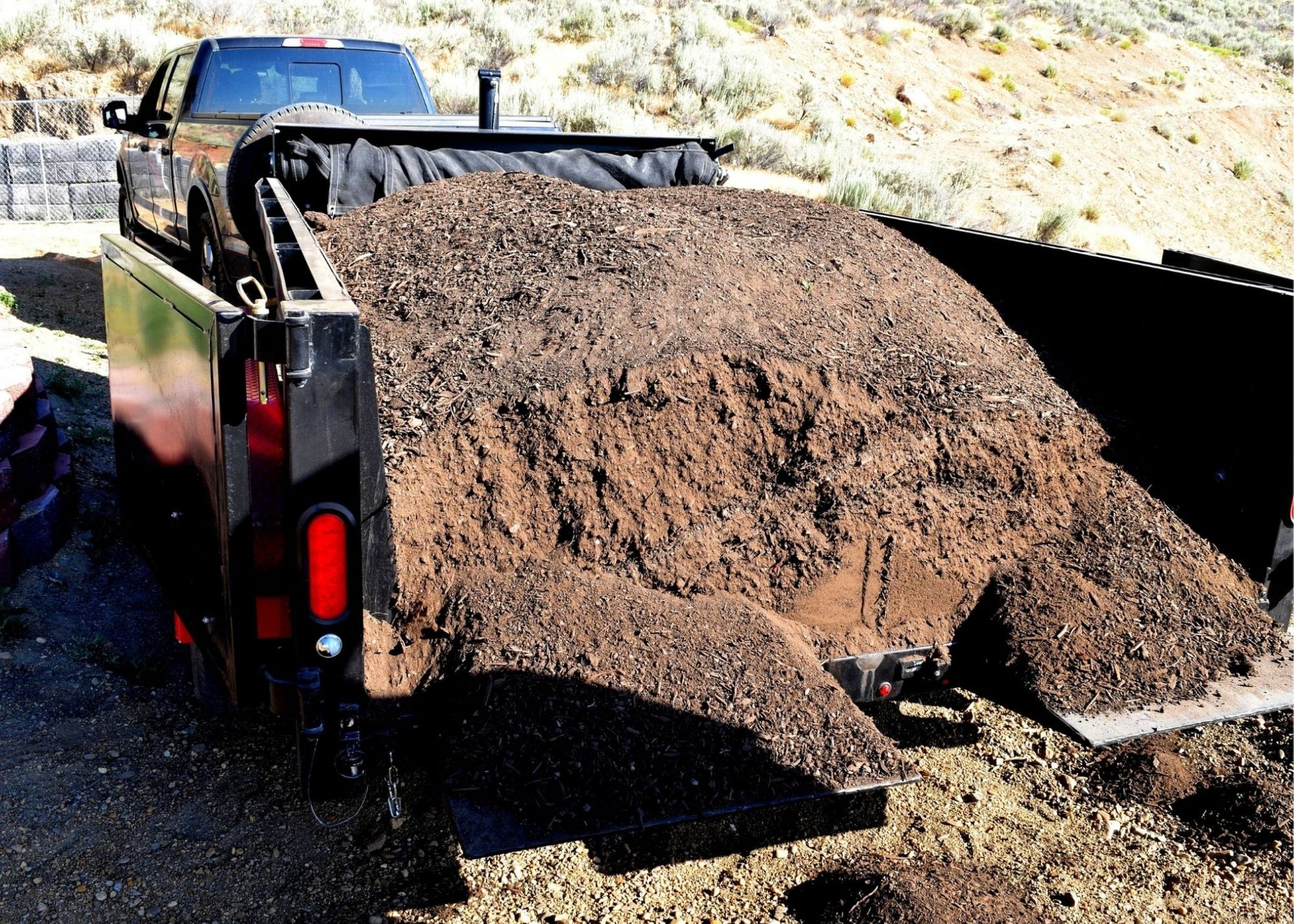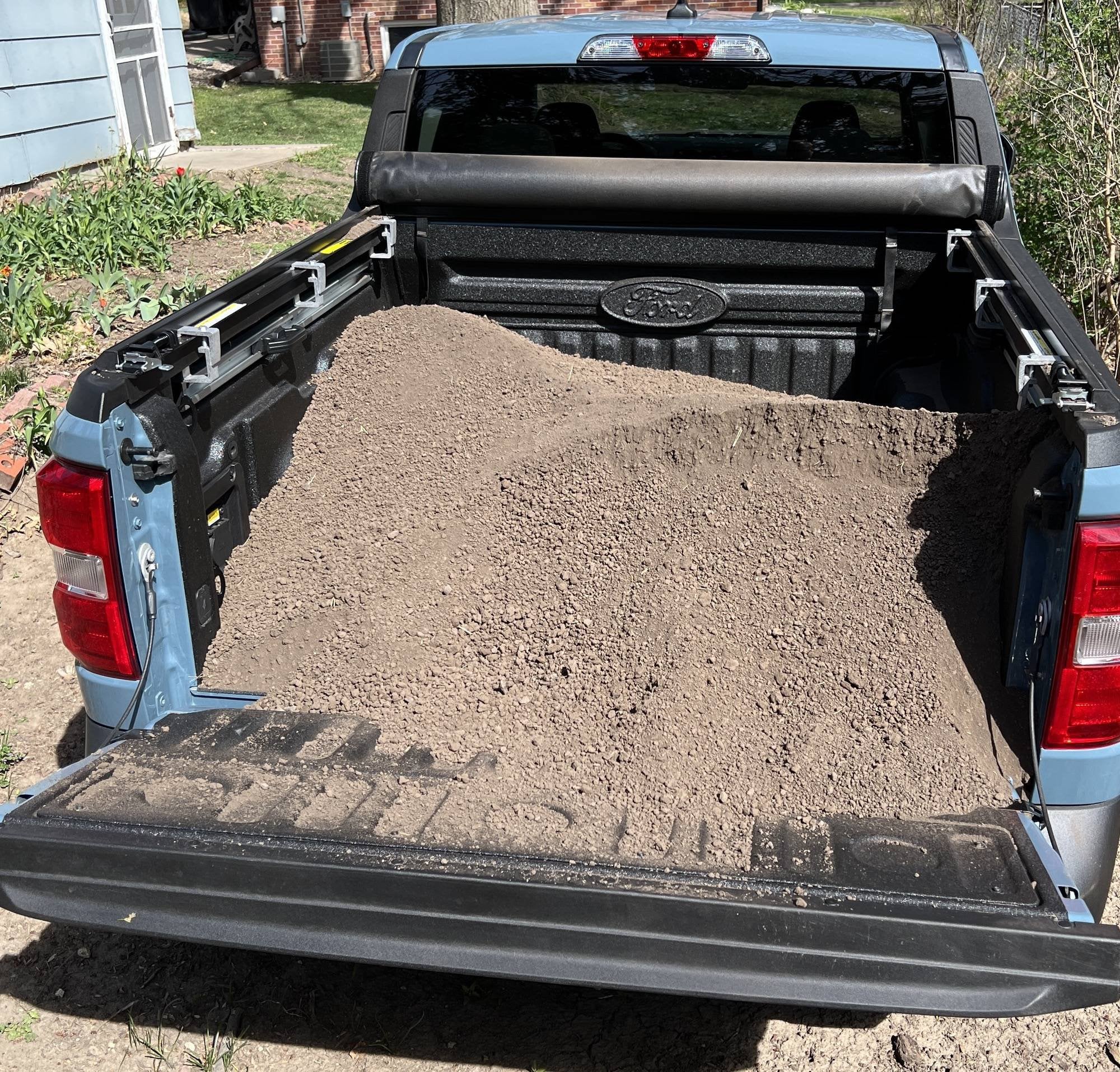How Many Yards of Dirt Can a F150 Hold? Find Out the Maximum Capacity!
An F150 pickup truck can hold approximately 1-2 cubic yards of dirt. The hauling capacity of the truck depends on its bed length and dimensions, with an average pickup truck capable of holding around 2,000 pounds or 1 cubic yard of material.
F150 trucks typically have a bed length of 82 inches, allowing for a maximum hauling capacity of 98. 2 inches. However, it is important to note that the actual amount of dirt the truck can hold may vary based on factors such as the moisture content and weight density of the dirt.

Credit: haulit.com
Understanding The Maximum Capacity Of A F150
When it comes to hauling materials like dirt, understanding the maximum capacity of your pickup truck is crucial. If you own an F150, you might be wondering how many yards of dirt it can hold. To answer that question, let’s delve into the factors affecting capacity and how to calculate the maximum capacity of an F150.
Various factors can influence the maximum capacity of an F150 when it comes to hauling dirt. Some of these factors include:
- The bed size: F150s come in different bed sizes, such as 5.5 feet, 6.5 feet, and 8 feet. The size of the bed directly affects how much dirt the truck can hold.
- The weight limit: Every truck has a specific weight limit that it can safely carry. Exceeding this limit can lead to damage and safety concerns. It’s essential to know the weight limit of your F150 before loading it with dirt.
- The suspension: The suspension system of the F150 plays a role in how much weight it can handle. Trucks with stronger suspension can usually carry more dirt compared to those with weaker suspension.
- The weight distribution: Proper weight distribution is crucial to maintain stability and prevent overloading. Distributing the dirt evenly in the bed ensures that the truck can handle the weight more effectively.
To calculate the maximum capacity of your F150 in terms of yards of dirt, you need to consider the bed dimensions and the recommended weight limit. Here’s a simple formula to help you calculate:
Maximum Capacity (in cubic yards) = Bed Length (in feet) x Bed Width (in feet) x Bed Height (in feet) x 0.037037
The result will give you an estimation of the maximum capacity in cubic yards. Keep in mind that this is a rough estimate, and factors like weight limit and weight distribution also need to be taken into account for safe hauling.
Now that you understand the factors affecting the maximum capacity of an F150 and how to calculate it, you can confidently determine how many yards of dirt your truck can hold. Just remember to always prioritize safety and adhere to the recommended weight limits to avoid any issues while hauling. Happy dirt hauling!
Factors Affecting Capacity
The capacity of a F150 truck to hold yards of dirt depends on various factors. These include the bed size, weight capacity, and distribution of the dirt. It is recommended to consult the truck’s specifications or seek professional advice for an accurate estimation.
When it comes to determining how many yards of dirt a Ford F150 pickup truck can hold, several factors come into play. Understanding these factors is essential to ensure a safe and efficient hauling experience. The most significant factors affecting the truck’s capacity include the truck bed size, truck suspension, and weight distribution.
Truck Bed Size
The size of the truck bed plays a crucial role in determining how much dirt the F150 can hold. The F150 comes with different bed lengths, including 5.5 feet, 6.5 feet, and 8 feet. The longer the bed, the more dirt it can accommodate. Here is a breakdown of the F150 bed sizes and their approximate maximum capacity in cubic yards:
| Truck Bed Length | Approximate Maximum Capacity (Cubic Yards) |
|---|---|
| 5.5 feet | 1.5 – 2.3 cubic yards |
| 6.5 feet | 1.8 – 2.8 cubic yards |
| 8 feet | 2.3 – 3.5 cubic yards |
Truck Suspension
The suspension system of the F150 also affects its hauling capacity. A well-maintained suspension can handle more weight without impacting the truck’s performance and stability. On the other hand, an excessive load can put strain on the suspension and lead to reduced control and potential damage. It’s important to consider the truck’s suspension capabilities and adhere to the manufacturer’s recommended weight limits to ensure safe hauling.
Weight Distribution
Proper weight distribution is essential to maintain control and stability while hauling dirt in an F150. Distributing the load evenly across the truck bed helps prevent excessive strain on one side and keeps the truck balanced. As a general rule, try to distribute the weight so that the heaviest part of the load is centered over the rear axle. This ensures optimal handling and minimizes the risk of the truck becoming top-heavy or losing control.
Calculating Maximum Capacity
If you’re planning on using your F150 truck to haul dirt, it’s important to know how much it can carry. One of the key measurements to consider is the maximum capacity in terms of cubic yards. In this section, we will explore how to calculate the maximum capacity of an F150 truck, so you can determine exactly how many yards of dirt it can hold.
Understanding Cubic Yards
Before we dive into calculating the maximum capacity, let’s first understand what cubic yards mean. A cubic yard is a unit of volume, specifically a cube that measures one yard on each side. In the context of hauling dirt, a cubic yard represents the amount of dirt that can fit in a container with dimensions of one yard in length, one yard in width, and one yard in height.
Determining Weight Capacity
When it comes to hauling dirt with your F150 truck, it’s not only important to consider the volume (in cubic yards) but also the weight capacity. Different trucks have varying weight capacities, which determine how much weight they can safely carry without causing damage or compromising safety.
To determine the weight capacity of your F150 truck, you can refer to the manufacturer’s specifications. These specifications typically include the Gross Vehicle Weight Rating (GVWR), which is the maximum weight the truck can handle, including the weight of the truck itself, passengers, and cargo. By knowing the GVWR, you can ensure that you don’t exceed the weight limit when loading dirt into your truck.
Once you have the weight capacity and the dimensions in cubic yards, you can calculate the maximum amount of dirt your F150 truck can hold. Remember to consider both the volume and weight capacity to ensure safe and efficient hauling.
Now that we’ve covered the basics of calculating the maximum capacity of an F150 truck, you can confidently plan your dirt-hauling projects, knowing exactly how many yards of dirt your truck can hold.
Real-life Examples Of Dirt Hauling
Are you wondering how many yards of dirt your pickup truck can hold? Look no further! In this section, we will explore real-life examples of dirt hauling capacity for different types of pickup trucks. Whether you own a half-ton or a full-size pickup truck, we’ve got you covered.
Half-ton Pickup Truck
If you own a half-ton pickup truck like the popular Ford F150, you might be surprised by its dirt hauling capabilities. On average, a half-ton pickup truck can transport around 2 to 3 cubic yards of dirt. That’s enough to tackle small to medium-sized landscaping projects or haul away debris from your backyard.
But how much exactly is 2 to 3 cubic yards of dirt?
Just to give you an idea, one cubic yard of dirt is roughly equivalent to:
- 27 standard-sized wheelbarrow loads
- A pile of dirt measuring about 3 feet high, 3 feet wide, and 3 feet deep
- The capacity of a small trailer
Keep in mind that these are approximate measurements and can vary depending on the density and moisture content of the dirt. It’s always a good idea to double-check with a professional if you have specific hauling needs.
Full-size Pickup Truck
If you need to tackle larger projects or have heavier hauling requirements, a full-size pickup truck might be the way to go. Trucks like the Ford F250 or F350 offer increased hauling capacity compared to their half-ton counterparts.
On average, a full-size pickup truck can handle around 3 to 4 cubic yards of dirt. With this capacity, you can take on larger landscaping projects or transport larger amounts of debris with ease.
So, how much dirt is 3 to 4 cubic yards?
Imagine a pile of dirt measuring approximately 4 feet high, 4 feet wide, and 4 feet deep. That’s roughly the amount of dirt your full-size pickup truck can handle.
Remember, these are just estimates, and the actual hauling capacity may vary depending on factors such as the weight distribution, suspension, and towing package of your truck.
Conclusion
Knowing the hauling capacity of your pickup truck is essential when taking on landscaping projects or transporting heavy materials like dirt. By understanding the dirt hauling capabilities of different types of pickup trucks, you can make informed decisions and plan your projects accordingly. So, whether you have a half-ton or a full-size pickup truck, you now have a better idea of how many yards of dirt your truck can hold.
Tips For Hauling Dirt Safely
Looking to haul dirt safely? Find out how many yards of dirt a F150 can hold and get expert tips for a successful hauling experience. Whether you’re landscaping or working on a construction project, this information will help you make sure you’re loading your truck safely and efficiently.
Loading Techniques
When it comes to hauling dirt in your F150, it’s essential to use proper loading techniques to ensure a safe and efficient transport. By following these simple tips, you can maximize the amount of dirt your truck can hold and minimize the risk of accidents. To start, park your F150 on level ground and engage the parking brake for added stability. Position the truck near the dirt pile, ensuring there is enough clearance to load without hitting any obstacles. When loading the dirt, consider using a shovel, wheelbarrow, or a loading ramp to make the process easier. Begin by filling the bed of the truck evenly, focusing on distributing the weight evenly to avoid straining the suspension.Securing The Load
Securing the load is crucial to prevent any dirt from falling out of the truck while driving. Invest in a sturdy tarp or cargo net that can cover the entire bed and secure it tightly to prevent any dirt from escaping. Make sure the tarp is secured using bungee cords or tie-down straps, ensuring it remains in place during the journey. Additionally, it’s essential to avoid overloading the truck beyond its weight capacity. Refer to your F150’s manual or consult with the manufacturer to determine the maximum weight it can safely carry. Overloading the truck can not only damage your vehicle but also increase the risk of accidents on the road. Remember, proper loading and securing techniques are necessary for a safe journey when hauling dirt in your F150. By following these tips, you can ensure a smooth and worry-free transport while maximizing the amount of dirt your truck can hold.
Credit: www.reddit.com

Credit: www.harborfreight.com
Frequently Asked Questions On How Many Yards Of Dirt Can A F150 Hold
Will 3 Yards Of Dirt Fit In A Pickup Truck?
Yes, a pickup truck can generally hold 3 yards of dirt. The bed capacity of a pickup truck is typically measured in cubic yards, and 3 yards of dirt can fit comfortably in most pickup trucks.
Will 2 Yards Of Mulch Fit In A Truck?
Yes, 2 yards of mulch will fit in a truck.
How Many Cubic Yards Of Dirt Can A Truck Hold?
A truck can hold approximately two cubic yards of dirt.
How Much Does 2 Yards Of Dirt Weigh?
Two yards of dirt weigh approximately 3,000 to 6,000 pounds.
Conclusion
To determine how many yards of dirt a Ford F150 pickup truck can hold, it is important to consider the bed capacity. While there may be variations depending on the specific model and variations in bed length, the average Ford F150 has a bed length of 82 inches and a maximum hauling capacity of 98.
2 inches. This means that the truck can hold approximately two cubic yards of dirt. It is always advisable to load the dirt evenly and avoid overloading the truck, as this can cause potential damage. So, when planning to haul dirt, keep in mind the bed capacity of your Ford F150.






